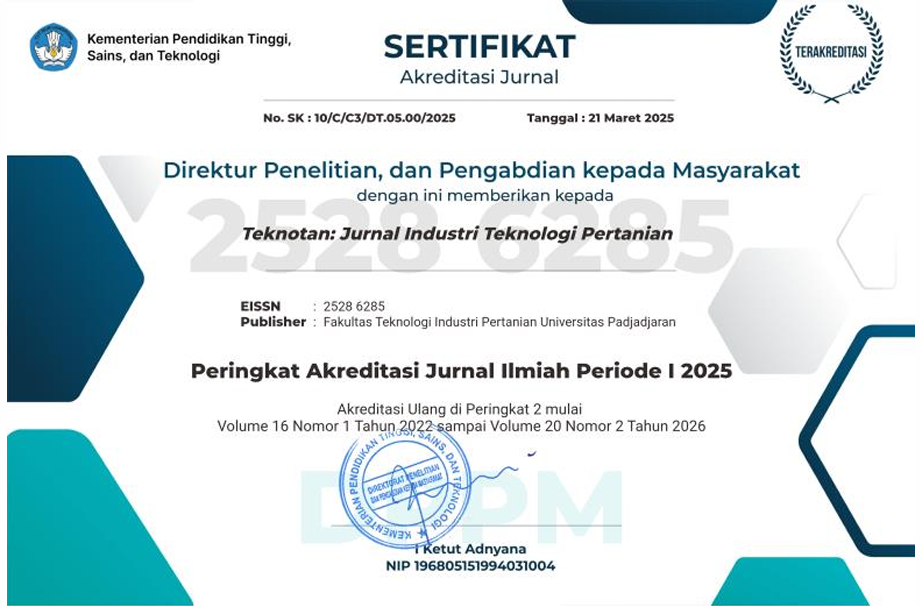Eksplorasi Potensi Akar Millettia sericea sebagai Sumber Antioksidan Alami
Abstract
Akar Millettia sericea merupakan salah satu tanaman khas Indonesia yang belum banyak diketahui manfaatnya. Penelitian ini bertujuan untuk (1) mengetahui sifat fisik, kimia, toksisitas dan kandungan fitokimia dalam akar Millettia sericea , dan (2) mengetahui sifat kelarutan senyawa antioksidan dalam beberapa jenis pelarut dan menduga jenis senyawa aktifnya. Metode penelitian yang digunakan adalah metode eksperimental-deskrkiptif yang diulang 3 kali. Hasil penelitian ini menunjukkan akar Millettia sericea mengandung senyawa fitokimia berupa fenolik, flavonoid dan tannin yang tinggi. Hal itu menjadi indikasi adanya potensi senyawa antioksidan dalam akar Millettia sericea . Ekstraksi akar ini menggunakan beberapa jenis pelarut yang berbeda kepolarannya menunjukkan bahwa senyawa antioksidan dalam akar Millettia sericea bersifat semi polar. Hal itu disebabkan antifitas antioksidan tertinggi dihasilkan dari pelarut metanol dan etanol. Hasil identifikasi berdasarkan berat molekulnya, terdapa 5 jenis senyawa aktif potensial yang bersifat antioksidan. Akar Millettia sericea ini telah menunjukkan potensinya sebagai alternatif sumber senyawa antioksidan alami, yang dapat dikembangkan untuk produk pangan dan kosmetik.
Keywords
Full Text:
PDF (Bahasa Indonesia)References
Aditiano, B., Ginting, S., Lubis, L. M. (2017). Stabilitas mutu nira aren kemasan dengan perlakuan fisik dan pengawet alami akar kawao selama penyimpanan dingin. J Rek Pang & Pert. 5 (1)
Baba, S. A., Malik, S. A. (2015). Determination of total phenolic and flavonoid content, antimicrobial and antioxidant activity of a roots extract of Arisaema jacquemontii Blume. J Taibah Univ Sci. 9(4): 449-454. doi:10.1016/j.jtusci.2014.11.001
Carballo, J. L., Inda, Z. L. H., Perez, P., Gravalos, M. D. G. (2002). A comparison between two brine shrimp assays to detect in vitro cytotoxicity in marine natural products. BMC Biotechnol. 17(2): 1186-1192.
Chawki, B. (2018). Phenanthrene and dihydrophenanthrene derivatives from Dioscorea communis with anticholinesterase, and antioxidant activities. Nat Prod Res. doi:10.1080/14786419.2018.1468328
Clarkson, C., Maharaj, V. J., Crouch, N. R., Grace, O. M., Pillay, P., Matsabisa, M. G., Bhagwandin, N., Smith, P. J., Folb, P. I. (2004). In vitro antiplasmodial activity of medicinal plants native to or naturalized in South Africa. J Ethnopharm. (92): 177-191
Derza, M. I., Karo-Karo, T., Ridwansyah. (2018). Pengaruh jenis dan konsentrasi pengawet alami terhadap mutu nira kelapa sawit (elaeis guineensis, jacq.). J Rek Pang & Pert. 6(4)
Departemen Kesehatan Republik Indonesia. (2009). Farmakope herbal Indonesia edisi pertama [diacu 2013 Agustus 31] Tersedia dari http://jdih.pom.go.id/showpDB.php?u=824
Dhanmane, S. K., Salih, F. A. (2018). Isolation of karanjin from Pongamia pinnata and its identification by difference analytical techniques. Kurdistan Journal of Applied Research (KJAR). doi:10.24017/science.2018.2.26
Elgorban, A. M., Bahkali, A. H., Wahab, M. A. A. (2018). Natural products of Alternaria sp, an endophytic fungus isolated from Salvadora persica from Saudi Arabia. Saudi J Biol Sci. doi:10.1016/j.sjbs.2018.04.010
Filianty, F., Raharja, S., Suryadarma, P. (2010). Perubahan kualitas nira tebu (Saccharum Officarum) selama penyimpanan dengan penambahan akar Millettia sericea (Millettia sp.) dan kulit batang manggis (Garcinia Mangostana L.) sebagai bahan pengawet. J Tek Ind Pert. 20 (1):57-64
Filianty, F., Sumanti, D. M. (2011). Identification of phytochemical compound and toxicity test in Millettia sericea roots extract (Millettia sp.). Proceeding UMTAS, Terengganu. Malaysia.
Filianty, F. (2007). Teknik Penghambatan Degradasi Sukrosa dalam Nira Tebu (Saccharum Officinarum) Menggunakan Akar Kawao (Millettia sericea ) dan Kulit Batang Manggis (Garcinia Mangostana L.).[Tesis]. Bogor : Institut Pertanian BogorGupta PC, Rao CV. 2012. Pharmacognostical studies of Cleome viscosa Linn. IJNPR. 3:527-534
Khan, H., Marya, Belwal, T., Tariq, M., Atanasov, A.G., Devkota, H.P.. (2019). Genus Vanda: A review on traditional uses, bioactive chemical constituents and pharmacological activities. J Ethnopharmacol. 229:46-53
Kim, G. N., Shin, J. G., Jang, H. D. (2009). Antioxidant and antidiabetic activity of Dangyuja (Citrus grandis Osbeck) extract treated with Aspergillus saitoi. Food Chem. 117 (1):35-41
Lee, J. H. (2015). In-vitro evaluation for antioxidant and anti-inflammatory property of flavanone derivatives. Food Biosci. 11:1-7
Meyer, B. N., Ferrigni, N. R., Putnam, J. E., Jacobsen, L. B., Nichols DE, McLaughlin JL. (1982). Brine bhrimp: a convenient general bioassay for active plant constituents. Planta Medica. (45):31-34
Oliveira, B. A., Rodrigues, A. C., Cardoso, B. M. I., Ramos, A. L. C. C., Bertoldi, M. C., Taylor, J. G., Cunha, L. R., Pinto, U. M. (2016). Antioxidant, antimicrobial and anti-quorum sensing activities of Rubus rosaefolius phenolic extract. Ind Crops Prod. 84:59-66. doi: 10.1016/j.indcrop.2016.01.037
Pandey, A., Larroche, C., Ricke, S. C., Dussap, C. G., Gnansoonou, E. (2011). Biofuels: Alternative Feedstock and Conversion. Processes Oxford. Elsevier Inc
Proestos, C., Chorianopoulos, N., Nychas, G. J. E., Komaitis, M. (2005). RP-HPLC analysis of the phenolic compounds of plant extracts. investigation of their antioxidant capacity and antimicrobial activity. J Agric Food Chem. 53(4):1190-1195. doi: 10.1021/jf040083t
Richardson, B. J., Mak, E., De Luca-Abbott, S. B., Martin, M., McClellan, K., Lam, P. K. S. (2008). Antioxidant responses to polycyclic aromatic hydrocarbons and organochlorine pesticides in green-lipped mussels (Perna viridis): Do mussels "integrate" biomarker responses? Mar Pollut Bull. 57(6-12):503-514.
Sengul, M., Yildiz, H., Gungor, N., Cetin, B., Eser, Z., Ercisli, S. (2009). Total phenolic content, antioxidant and antimicrobial activities of some medicinal plants. Pak. J Pharm Sci. 22(1):102-106
Shoge, M., Garba, S., Labaran, S. (2014). Antimicrobial activity of 1,2 butyldecyl ester isolated from the seeds and pods of Acacia nilotica. Basic Research Journal of Microbiology (BRJMB). ISSN 2354. Available online : http//www.basicresearchjournals.org
Sokanandi, A., Pari, G., Setiawan, D., Saepuloh. (2014). Komponen kimia sepuluh jenis kayu kurang dikenal : kemungkinan penggunaan sebagai bahan baku (3): 209-220
Tian, R. R., Pan, Q. H., Zhan, J. C., Li, J. M., Wan, S. B., Zhang, Q. H., Huang, W. D. (2009). Comparison of phenolic acids and flavan-3-ols during wine fermentation of grapes with different harvest times. Molecules. 14:827-838
Yeni, G., Sa'id, E. G., Syamsu, K., Mardliyati, E. (2014). Penentuan kondisi terbaik ekstraksi antioksidan dari gambir menggunakan metode permukaan respon. J Lit Ind. 4(1): 39-48
Yi, D., Wang, Z., Yi, L. (2015). Development and validation of an LC–MS method for determination of karanjin in rat plasma: application to preclinical pharmacokinetics. J Chromatogr Sci. 53(4):456–461. doi: https://doi.org/10.1093/chromsci/bmu064
DOI: https://doi.org/10.24198/jt.vol15n2.9
Refbacks
- There are currently no refbacks.
Indexed by:

This work is licensed under a Creative Commons Attribution 4.0 International License (CC BY-SA 4.0)


1.png)
.png)







